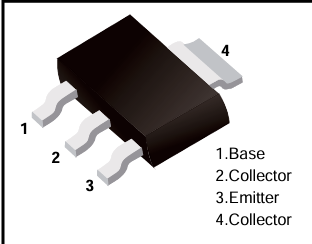Date:2025-05-15 Categories:Product knowledge Hits:397 From:Guangdong Youfeng Microelectronics Co., Ltd
5. Amplification Mechanism
When a small alternating current (AC) signal is superimposed on the DC bias current at the base terminal of a transistor in the active mode, it causes the base current to vary slightly. This small variation in the base current is then amplified and results in a much larger variation in the collector current.
small-signal transistorFor instance, in an audio amplifier circuit, a small audio signal (a varying voltage representing sound waves) is applied to the base of the transistor. As the base voltage changes, the base current changes accordingly. The transistor then amplifies this change in base current, and the amplified signal appears as a larger variation in the collector current. This amplified current can then be converted back into a larger voltage signal using a load resistor connected in series with the collector terminal, effectively amplifying the original audio signal.
6. Input and Output Characteristics
6.1 Input Characteristics
The input characteristic of a
small-signal transistor shows the relationship between the base-emitter voltage (
) and the base current (
). In the active region,
increases exponentially with an increase in
. Typically, for a silicon BJT, the
is approximately 0.7 V when the transistor is conducting in the active mode. This characteristic is important for biasing the transistor correctly to ensure it operates in the desired region for small-signal amplification.
small-signal transistor6.2 Output Characteristics
The output characteristic depicts the relationship between the collector-emitter voltage (
) and the collector current (
) for different values of the base current (
). In the active region,
remains relatively constant for a fixed
as
increases, indicating the transistor's ability to act as a current source. However, when
becomes too low, the transistor enters the saturation region, and
no longer increases proportionally with
.
7. Applications of Small-Signal Transistors
small-signal transistor find extensive use in a wide range of applications. In audio systems, they are used to amplify weak audio signals from microphones or other sources to a level suitable for driving speakers. In RF circuits,
small-signal transistor are employed for tasks such as signal amplification, frequency mixing, and oscillation generation, enabling the reception and transmission of radio signals. Additionally, in electronic measurement instruments like oscilloscopes and signal generators, these transistors play a vital role in signal conditioning and amplification to ensure accurate and reliable operation.
In conclusion, the working principle of
small-signal transistor is based on their unique semiconductor structure and the ability to control and amplify current in the active mode. Understanding these principles is essential for designing and analyzing various electronic circuits that rely on the amplification and processing of small electrical signals. As technology continues to evolve,
small-signal transistor will remain a cornerstone in the field of electronics, driving innovation in countless applications.

